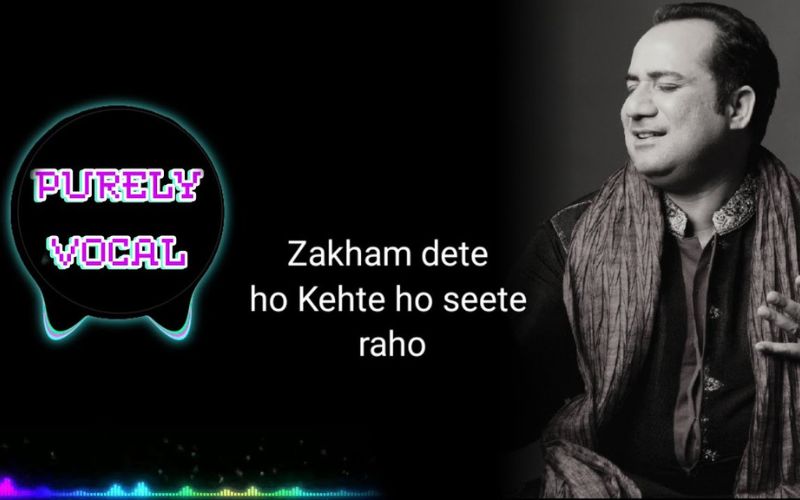“Zakhm Dete Ho Kehte Ho Seete Raho” is a poignant and emotive song that has captured the hearts of music lovers across generations. This evocative composition, with its powerful lyrics and soulful melody, delves into the depths of human emotions, exploring themes of love, loss, and the resilience of the human spirit.
The song’s title, which translates to “You Inflict Wounds, Yet Ask Me to Remain Silent,” sets the tone for a profound exploration of the complexities of human relationships and the inner turmoil that often accompanies them. Through its haunting verses and stirring chorus, the song invites listeners to reflect on their own experiences, inviting them to connect with the universal truths that lie at the heart of this timeless musical masterpiece.
Meaning and interpretation of the lyrics
The lyrics of “Zakhm Dete Ho Kehte Ho Seete Raho” are a poetic tapestry that weaves together a tapestry of emotions, painting a vivid picture of the human experience. At its core, the song explores the paradoxical nature of love, where the very same person who inflicts wounds can also demand silence and acquiescence.
The opening lines, “Zakhm dete ho, kehte ho seete raho” (You inflict wounds, yet ask me to remain silent), set the stage for a powerful exploration of the duality of love. The lyrics then delve deeper, questioning the logic behind such a demand, as the singer laments, “Kyun chup rahe, kyun seete rahe?” (Why should I remain silent, why should I stay quiet?).
The song’s verses continue to unravel the complexity of the human heart, with lines that speak of the pain of betrayal, the anguish of unrequited love, and the longing for a love that is true and pure. The chorus, with its haunting refrain, “Zakhm dete ho, kehte ho seete raho,” serves as a powerful reminder of the duality that lies at the heart of the human experience.
Popular renditions of the song
“Zakhm Dete Ho Kehte Ho Seete Raho” has been performed and recorded by numerous artists over the years, each bringing their own unique interpretation to the song. Some of the most popular renditions include:
- Sonu Nigam’s Soulful Version: Sonu Nigam’s powerful and emotive rendition of the song has become a classic, showcasing his exceptional vocal range and the depth of his emotional connection to the lyrics.
- Shreya Ghoshal’s Haunting Cover: Shreya Ghoshal’s rendition of the song is a hauntingly beautiful interpretation, with her angelic voice capturing the essence of the lyrics and the underlying melancholy.
- Arijit Singh’s Heartfelt Rendition: Arijit Singh’s version of the song is a masterful blend of technical prowess and emotional depth, making it a standout among the many interpretations of this timeless classic.
- Sunidhi Chauhan’s Powerful Performance: Sunidhi Chauhan’s rendition of “Zakhm Dete Ho Kehte Ho Seete Raho” is a tour de force, showcasing her incredible vocal range and the raw power of her performance.
These are just a few examples of the many talented artists who have lent their voices to this beloved song, each offering a unique and captivating interpretation that has contributed to its enduring popularity and legacy.
Historical context and significance of the song
“Zakhm Dete Ho Kehte Ho Seete Raho” holds a significant place in the annals of Indian music, with its origins tracing back to the golden era of Hindi cinema. The song was originally composed for the 1982 film “Dard” and featured the legendary Lata Mangeshkar in the lead vocals.
The song’s enduring popularity and cultural significance can be attributed to its ability to resonate with audiences across generations. The timeless themes of love, loss, and the complexities of human relationships have struck a chord with listeners, making “Zakhm Dete Ho Kehte Ho Seete Raho” a staple in the repertoire of many renowned artists.
Moreover, the song’s poetic and introspective lyrics have earned it a place among the most celebrated works of Hindi lyrical poetry. The depth and nuance of the language used in the song have inspired countless artists, poets, and writers to explore the human condition in their own creative endeavors.
Today, “Zakhm Dete Ho Kehte Ho Seete Raho” stands as a testament to the enduring power of music to capture the essence of the human experience. Its continued relevance and impact on the cultural landscape of India, and beyond, solidify its status as a timeless classic that will continue to inspire and captivate audiences for generations to come.
Analysis of the poetic elements in the lyrics
The lyrics of “Zakhm Dete Ho Kehte Ho Seete Raho” are a masterful blend of poetic devices and literary techniques that elevate the song to the realm of high art. The use of metaphor, symbolism, and vivid imagery create a tapestry of emotions that resonates deeply with the listener.
One of the most striking elements of the lyrics is the use of paradox, as exemplified by the title itself. The juxtaposition of “zakhm dete ho” (you inflict wounds) and “kehte ho seete raho” (yet ask me to remain silent) sets the stage for a profound exploration of the duality inherent in human relationships.
The lyrics also employ the use of rhetorical questions, such as “Kyun chup rahe, kyun seete rahe?” (Why should I remain silent, why should I stay quiet?), which serves to engage the listener and invite them to ponder the complexities of the human experience.
Furthermore, the poetic devices of alliteration and assonance are skillfully woven throughout the lyrics, lending a lyrical quality to the composition and enhancing its rhythmic flow. The use of evocative imagery, such as “dil mera toot gaya” (my heart has broken) and “aankhon mein aansu share” (tears fill my eyes), create vivid mental landscapes that draw the listener deeper into the emotional journey of the song.
The overall effect of the poetic elements in the lyrics of “Zakhm Dete Ho Kehte Ho Seete Raho” is a powerful and profound exploration of the human condition, where the pain of love and the resilience of the spirit are seamlessly intertwined.
Impact and reception of the song
“Zakhm Dete Ho Kehte Ho Seete Raho” has had a profound and lasting impact on the cultural landscape of India and beyond. Since its release, the song has become a beloved classic, transcending the boundaries of its original cinematic context and becoming a staple in the repertoire of many renowned artists.
The song’s enduring popularity can be attributed to its ability to connect with audiences on a deeply emotional level. The poignant lyrics and soulful melody have resonated with listeners from all walks of life, who have found solace and catharsis in the song’s exploration of the complexities of human relationships.
The critical reception of “Zakhm Dete Ho Kehte Ho Seete Raho” has been overwhelmingly positive, with the song being praised for its artistic merit and its ability to capture the essence of the human experience. Music critics and scholars have lauded the song’s poetic elements, its technical prowess, and its enduring relevance in the cultural landscape.
Moreover, the song’s impact has extended beyond the realm of music, with its lyrics being widely quoted and referenced in literature, poetry, and even popular culture. The song’s ability to articulate the universal truths of love, loss, and resilience has made it a touchstone for artists and thinkers alike, who have drawn inspiration from its timeless message.
Today, “Zakhm Dete Ho Kehte Ho Seete Raho” stands as a testament to the power of music to transcend the boundaries of time and space, connecting with audiences across generations and cultures. Its enduring legacy and continued relevance in the hearts and minds of music lovers around the world are a testament to the song’s enduring impact and significance.
Translations and variations of the lyrics
The enduring popularity of “Zakhm Dete Ho Kehte Ho Seete Raho” has led to the song being translated and adapted into a variety of languages, allowing it to reach a wider audience and connect with listeners across linguistic and cultural boundaries.
One of the most notable translations of the song is the English version, which has been performed by several artists, including Shreya Ghoshal’s rendition. The English lyrics, while not a direct translation, capture the essence of the original Hindi lyrics, allowing non-Hindi speakers to engage with the song’s powerful themes and emotional resonance.
In addition to the English translation, the song has also been adapted into various regional languages, such as Punjabi, Gujarati, and Marathi, among others. These variations often incorporate elements of local folk music and cultural traditions, creating a unique and enriching interpretation of the original composition.
The diversity of translations and adaptations of “Zakhm Dete Ho Kehte Ho Seete Raho” is a testament to the song’s universal appeal and its ability to transcend linguistic and cultural boundaries. Each interpretation adds a new layer of depth and nuance to the original work, allowing the song to resonate with an ever-widening audience.
Moreover, the existence of these translations and variations serves as a testament to the enduring legacy of the song, as it continues to inspire and captivate audiences across generations and around the world.
Exploring the emotions portrayed in the lyrics
The lyrics of “Zakhm Dete Ho Kehte Ho Seete Raho” are a powerful exploration of the full spectrum of human emotions, delving into the complexities of love, loss, and the resilience of the human spirit.
At the heart of the song lies the paradox of love, where the very person who inflicts wounds also demands silence and acquiescence. This duality is a reflection of the often-conflicting emotions that arise in the context of intimate relationships, where love and pain can coexist in a delicate balance.
The lyrics capture the anguish of betrayal, the agony of unrequited love, and the longing for a love that is true and pure. The use of vivid imagery, such as “dil mera toot gaya” (my heart has broken) and “aankhon mein aansu bhare” (tears fill my eyes), evokes a visceral emotional response from the listener, drawing them into the emotional journey of the song.
However, the lyrics also hint at the resilience of the human spirit, as the singer questions the logic behind the demand for silence, refusing to be silenced in the face of pain and betrayal. This defiant stance serves as a testament to the strength and determination of the human heart, even in the face of overwhelming adversity.
The emotional range of “Zakhm Dete Ho Kehte Ho Seete Raho” is a testament to the depth and complexity of the human experience. The song’s ability to capture the nuances of love, loss, and resilience has made it a timeless classic that continues to resonate with audiences across generations.
Memorable performances and covers of the song
“Zakhm Dete Ho Kehte Ho Seete Raho” has been the subject of numerous memorable performances and covers by some of the most acclaimed artists in the industry. These interpretations have not only showcased the technical prowess of the performers but have also added new layers of depth and emotion to the timeless classic.
One of the most iconic performances of the song was by the legendary Lata Mangeshkar, the original vocalist for the song. Mangeshkar’s rendition is a masterclass in vocal control and emotional expression, as she effortlessly navigates the song’s intricate melodies and poignant lyrics.
Another standout performance was by Sonu Nigam, whose soulful and powerful interpretation of the song has become a fan favorite. Nigam’s ability to capture the raw intensity of the lyrics and the underlying melancholy has earned him widespread acclaim and cemented his status as one of the most versatile and emotive vocalists in the industry.
Shreya Ghoshal’s haunting cover of the song is a testament to her versatility as an artist. Ghoshal’s version is a masterful blend of technical prowess and emotional depth, as she seamlessly transitions between the song’s delicate passages and its more powerful moments.
In addition to these celebrated performances, “Zakhm Dete Ho Kehte Ho Seete Raho” has also been the subject of numerous covers by up-and-coming artists, who have brought their own unique interpretations to the timeless classic. These renditions have not only introduced the song to a new generation of listeners but have also contributed to its enduring legacy as a beloved and influential work of art.
Regardless of the performer or the interpretation, “Zakhm Dete Ho Kehte Ho Seete Raho” has consistently proven to be a platform for artists to showcase their technical prowess, emotional depth, and creative vision, cementing its status as a true masterpiece of Indian music.
Conclusion
“Zakhm Dete Ho Kehte Ho Seete Raho” is a timeless classic that has captivated audiences for generations. With its poignant lyrics, soulful melody, and enduring emotional resonance, the song has become a beloved staple in the pantheon of Indian music.
Through its exploration of the complexities of love, loss, and the resilience of the human spirit, “Zakhm Dete Ho Kehte Ho Seete Raho” has transcended the boundaries of its original cinematic context and become a cultural touchstone, inspiring artists, poets, and thinkers alike.
The song’s enduring popularity and critical acclaim are a testament to its enduring relevance and the universal truths it captures. Whether in its original form or through the countless interpretations and adaptations that have emerged over the years, “Zakhm Dete Ho Kehte Ho Seete Raho” continues to captivate and inspire audiences around the world.
As you delve deeper into the lyrics, the poetic elements, and the emotional journey of this timeless classic, you’ll find yourself drawn into a world of profound introspection and a renewed appreciation for the complexities of the human experience. So, let the haunting melodies and the evocative words of “Zakhm Dete Ho Kehte Ho Seete Raho” transport you to a realm where the heart’s deepest emotions are laid bare, and the resilience of the human spirit shines through.
If you’ve been moved by the powerful lyrics and soulful melodies of “Zakhm Dete Ho Kehte Ho Seete Raho,” we invite you to explore more of the rich tapestry of Indian music. Check out our curated playlists and articles that delve into the history, cultural significance, and artistic brilliance of this vibrant musical tradition. Join us on a journey of discovery and let the timeless classics of Indian music inspire and captivate you.





